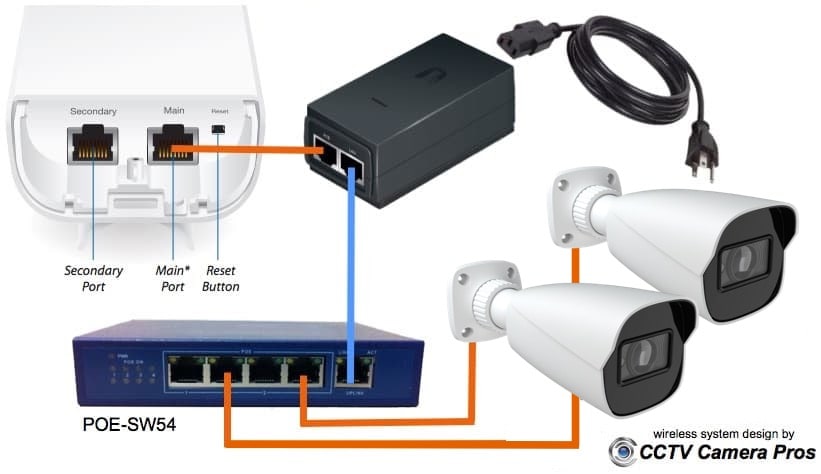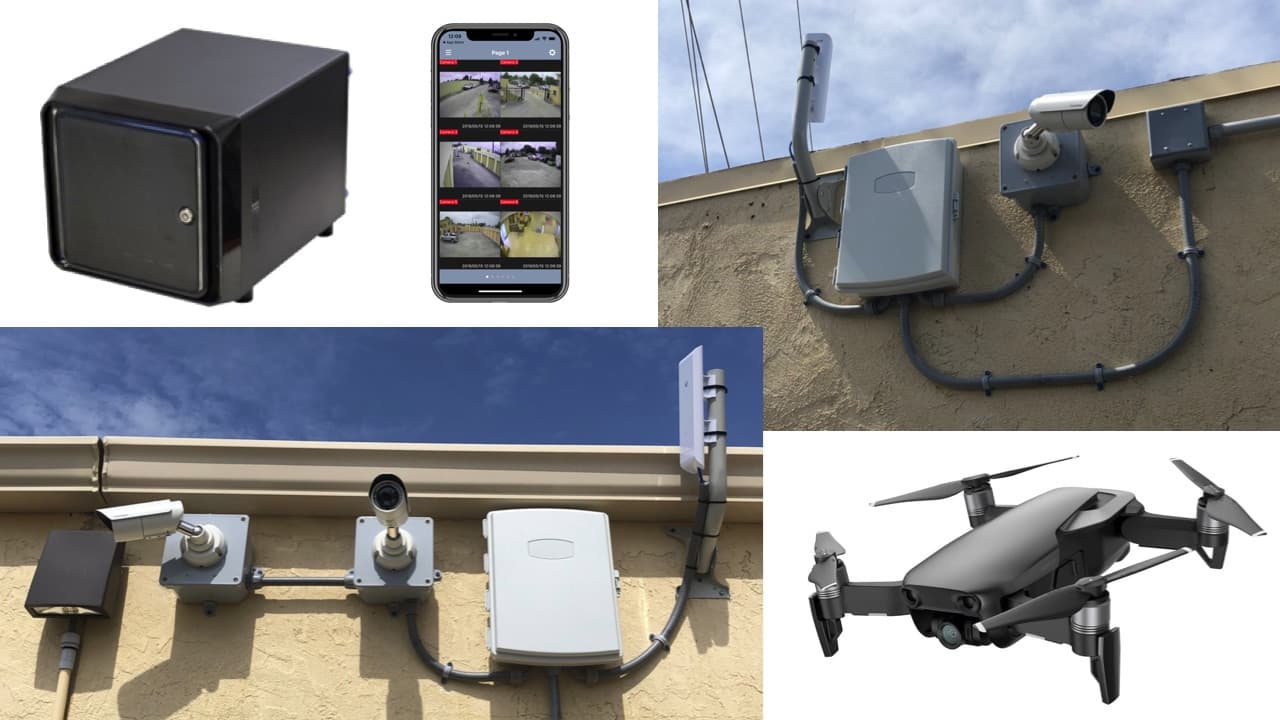The WIFI-EH9500 wireless camera antenna consists of a
pair of long-range wireless antennas that transmits at 5Ghz to avoid interference from 2.4GHz devices. One antenna acts as the transmitter and the other acts as the receiver to create an outdoor wireless network bridge that can be used with IP security cameras create a wireless camera system. You can even transmit multiple IP cameras over a single wireless bridge.
This wireless camera antenna is
weatherproof for outdoor or indoor use and capable of transmitting up to 150+Mbps up to 3 miles with a direct line of sight. It complies with the IEEE802.11 a/n wireless protocol. The security feature of the WIFI-EH9500 supports 64/ 128/ 256 bit WEP encryption, WPA/ WPA2, 802.1x authentication, hidden SSID and MAC address filtering.
This WIFI bridge can
transmit a single or multiple network IP cameras or CCTV cameras (using network video servers) to a central DVR/NVR without expensive cable dredging. Click here for a sample wireless installation explanation. You can also watch this video to see how these wireless antennas can be used in a security camera system that spans multiple buildings. CCTV Camera Pros uses this system for an LPR camera system at our warehouse. This system can be used to provide a cost-effective solution for remote and hard-to-reach camera locations where dredging and cable laying is not practical or is too expensive. Many of our customers use these antenna systems to connect cameras located at different buildings back to a central building where their main network and / Internet connection is located.
Enable Wireless on Indoor & Outdoor IP Cameras

The WIFI-EH9500 point to point long range wireless system works with all
IP cameras (indoor and outdoor). CCTV Camera Pros highly recommends Viewtron IP cameras. You can learn more here about wireless system installation.
Wireless Camera Antenna Features
- System Includes Long Range Wireless Transmitter & Receiver Antennas
- Wireless Transmission up to 3 miles (direct line of sight)
- Point-to-point Applications
- Can also be used for shorter distances. E.G connecting adjacent buildings
- Frequency: 5GHz to avoid interference from 2.4GHz network devices
- 16dBi Gain Antenna
- 150+ Mbps Data Transfer Rate
- Transmit video from a single or multiple IP Security Cameras
- Transmit video multiple CCTV Cameras using video servers
- Connect CCTV DVRs over WIFI
- Outdoor UV Stabilized Plastic Weatherproof IP66 Enclosure
- Multiple Security Encryption
- Mounting Kit Included
- Point-to-Point Wireless Applications
- Multiple Modes: Access Point, Client Bridge, Client Router
- CAT-5 / RJ-45 Ethernet Interface
- Power Over Ethernet Injector Included
- DC Power Supply Included
Custom Wireless Surveillance Systems

Not sure exactly what you need? Do you require a more complex setup and need some advice? CCTV Camera Pros can help design a security camera system with a wireless bridge to connect multiple structures over WIFI. We design custom system that include: point-to-point wireless bridges, point-to-multipoint wireless bridge systems to connect multiple buildings, long-range wireless antennas, indoor and outdoor IP cameras with AI software, PoE network switches, IP camera NVRs, hybrid CCTV DVRs that work with analog CCTV and network IP cameras, cables, and any other accessories and tools that you need. Please click here to get started and a design engineer with be in touch with you within 2 business days.

Connect Cameras on Multiple Buildings
Watch this video to see how this wireless system was used to design a system for a customer with a house and barn. CCTV Camera Pros highly recommends
Viewtron IP cameras and Viewtron IP camera NVRs for these types of systems.
Watch this video to see how we use this wireless system at CCTV Camera Pros warehouse in West Palm Beach, Florida. We are using these wireless antennas to transmit HD video from 3 security cameras mounted on a pole behind our building. The
LPR camera system that we installed is working great. This was an important demonstration because license plate recognition requires high quality video and frame rate. The fact that we are able to do this over WIFI is important to document for our customers. This is the LPR IP camera that we use, and these are the AI security cameras that we use for the overview cameras. You can learn more about this outdoor wireless camera system here.

The above diagram shows how 2 IP cameras connected to a
PoE switch so that the video signal from both IP cameras can be transmitted over a single wireless bridge. The uplink port of the PoE switch is connected to the main port of the transmitting antenna.
Wireless System Mount Options

The WIFI-EN95610 system comes standard with a pole mounting kit. The
optional J-pipe wall mounting bracket supports wall and roof mounting and can be added as an option to this system.
You can read additional details about the below examples in this blog post written by CCTV Camera Pros co-founder, Mike Haldas:
"How to Remotely View a Security Camera Installed at a Location with No Internet Access".
Wireless IP Camera System

The above installation transmits a single IP camera from a building that has no Internet / network connectivity (building on the left) but does have power. The video from the IP camera is transmitted to the building on the right where there is an active high-speed Internet connection. The owner of this system can enable remote access to this camera so that it can be viewed from desktop and mobile devices including Windows, Mac, iOS (iPhone and iPad), and Android.
Wireless IP Camera System with Multiple Cameras

This installation connects multiple IP cameras in the building on the left using a network switch. The switch is then connected to the transmitting antenna so that the video from all 4 IP cameras are connected wireless to the building on the right. Again, the building on the right has an Internet connection and all camera can be enabled for remote viewing.
Wireless CCTV Camera System

This installation shows how to use a wireless system to connect a CCTV camera system with a network-able DVR.
CCTV DVRs that we supply has a built-in Ethernet port so that the DVR can be monitored over a network and Internet connection. In this installation, the CCTV cameras are hard-wired to the DVR using RG59 coaxial cable and the DVR is connected to the wireless bridge with a CAT-5 cable. The wireless bridge in this scenario connects the whole. The iDVR includes desktop and mobile apps for Macintosh, Windows, iOS, and Android. By setting up port forwarding on the router in the building on the right, users can access their DVR and live camera views.

This video reviews an outdoor wireless security camera design that spans multiple buildings. This system is installed at a self storage facility in Boynton Beach, Florida. We used a drone to capture video of the installation and to show the size of the property. This system uses
WIFI-NAN5 wireless transmitters, a WIFI-OMNI5 omni-directional antenna, GeoVision IP cameras, and a custom built PC-based GeoVision NVR.
You can learn more about this
self storage security camera system design here.
Hybrid CCTV Camera and IP Camera System

The above sample installation shows how this wireless system can deploy a surveillance system across multiple buildings that are not wired together or even on the same IP network. Internet networks are not mandatory to use this system. Internet can be added to building A if the user wants to setup remote camera viewing from over the Internet.
In this example, building A contains two CCTV cameras (analog cameras) that are wired directly to the hybrid NVR / DVR using
RG59 coax cable or pre-made plug and play CCTV cables. The NVR is connected to the network of building A by connecting to the router via cat-5 cable.
To the right of the router is a cable or DSL modem which will allow Internet access to the entire system if desired. To the left of the router in building A, and
mounted on the outside wall is the wireless system receiver.
The building A wireless receiver is connected
wireless to the wireless transmitter on building B, which is located within a direct line of sight for communication (direct line of sight is required between antennas. Building B's wireless transmitter is connected to a network switch in building B (not a router) via CAT-5 cable.
The
network switch is connected to two network video servers via CAT5 cable. The network video servers are each connected to a CCTV camera using RG59 coax cable or a premade CCTV cables.
The purpose of the
network servers is to convert the camera’s analog video signal to digital and transmits it using TCP/IP to the network via the network switch.
The wireless camera system's transmitter and receiver create a
wireless network. The router in building A assigns IP addresses to all of the devices in building B and in turn, make building B's IP devices part of building A's network.
The hybrid DVR / NVR in building A is capable of
connecting to both wired CCTV cameras as well as IP cameras, and IP video servers, bringing both buildings cameras together into a single surveillance system.
With building A high-speed internet access in place and port forwarding / firewall settings properly set-up, users are able to
remotely access all cameras from both buildings over the Internet simply by connecting to the NVR / DVR's web camera service.
Wireless Camera System Technical Specification
Click here to view the
WIFI-EH9500 wireless camera system technical specification.











 Works good
Works good 




